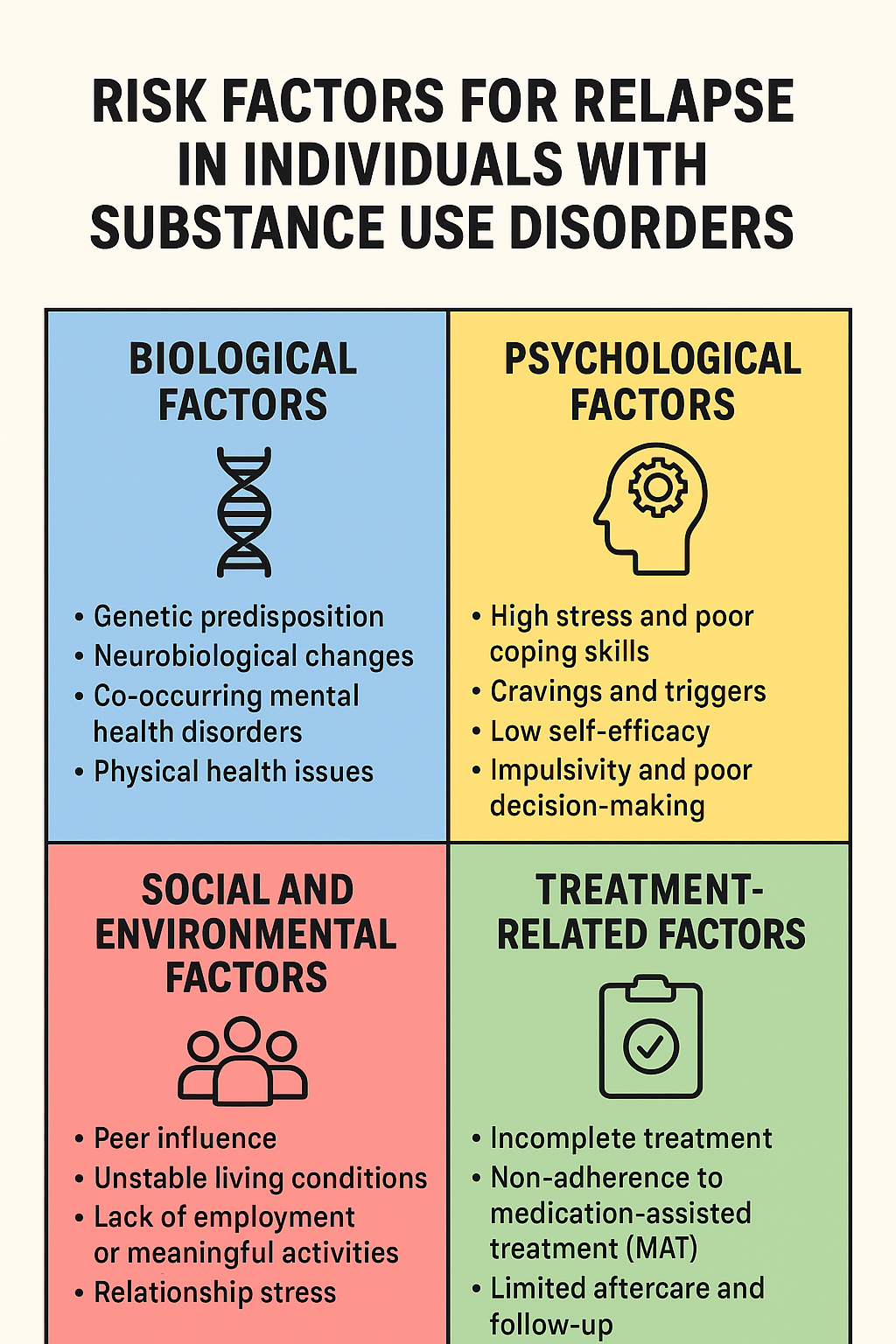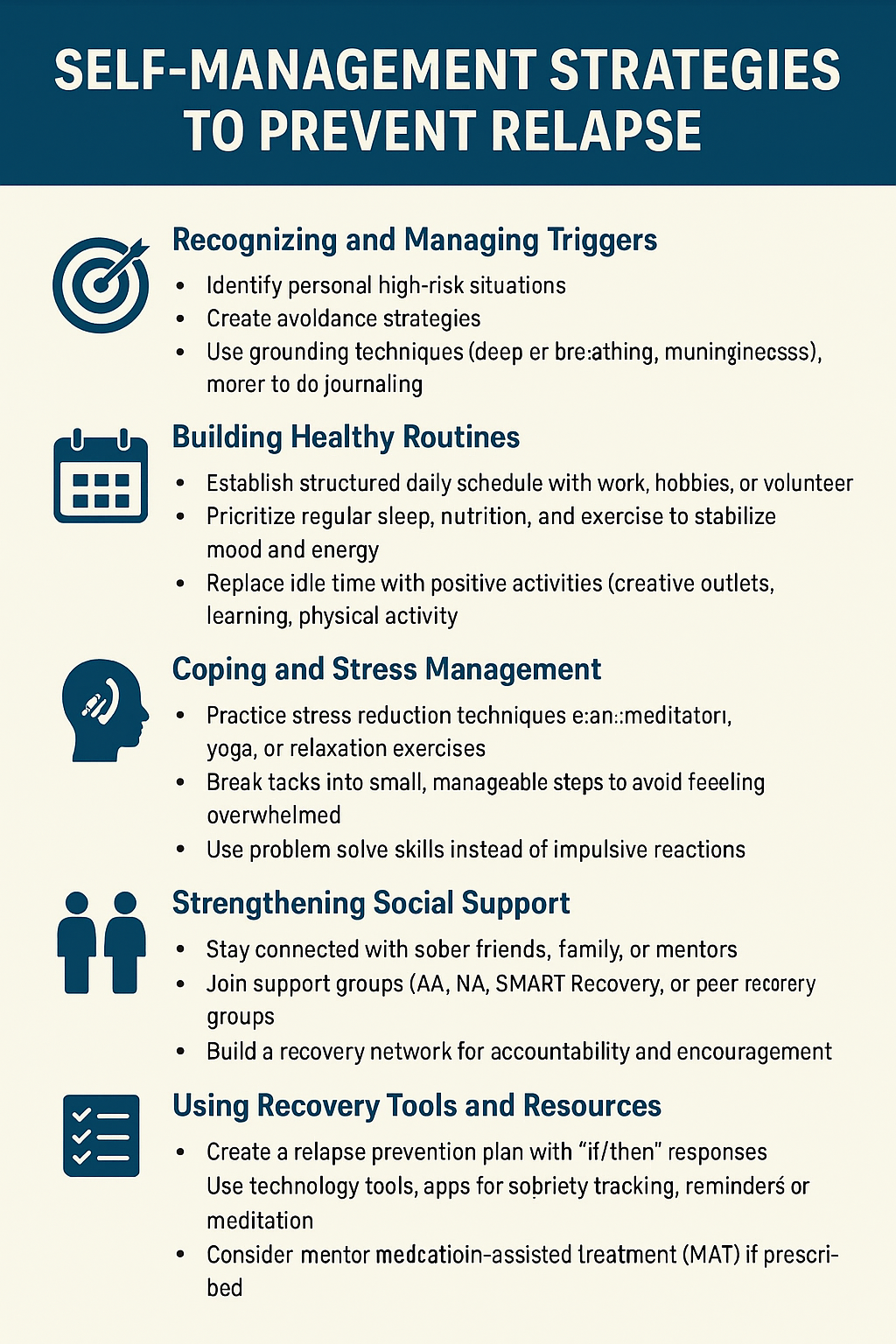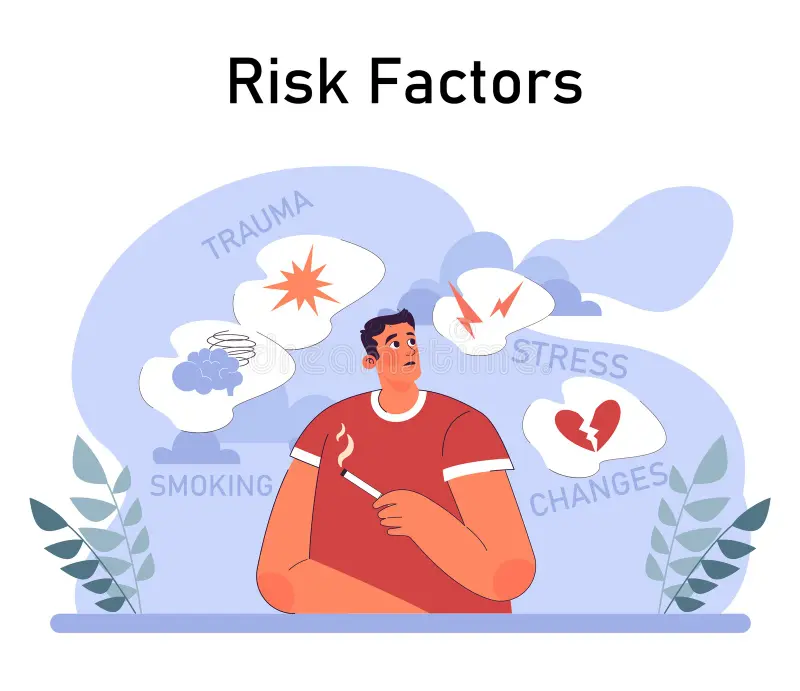Relapse is one of the greatest challenges in overcoming substance use disorders, often triggered by stress, cravings, or social pressures. It is not just about willpower—relapse reflects the complex mix of biological, psychological, and environmental factors that can make recovery fragile. Preventing relapse works best through a comprehensive, team-based approach. Self-management skills, like coping strategies and mindfulness, help individuals recognize and manage triggers. Family involvement offers emotional support and accountability, while community resources—such as healthcare, housing, and peer groups—provide structure and encouragement. Together, these supports create a strong foundation that empowers people to maintain sobriety and build long-term recovery.
Understanding Risk Factors for Relapse in Substance Use Disorders
Relapse in individuals with substance use disorders (SUDs) is not the result of a single cause. Instead, it is shaped by the interaction of biological, psychological, social, and treatment-related factors. Recognizing these risk factors is key for prevention and for building treatment plans that support long-term recovery.
1. Biological Factors
- Genetic predisposition: A family history of addiction raises vulnerability.
- Neurobiological changes: Chronic substance use rewires the brain’s reward circuits, weakens stress regulation, and impairs decision-making, making cravings stronger.
- Co-occurring mental health conditions: Untreated depression, anxiety, bipolar disorder, or ADHD increase relapse risk.
- Physical health issues: Chronic pain or other medical problems can lead to self-medication.
2. Psychological Factors
- High stress and poor coping skills: Difficulty handling stress makes individuals more likely to turn to substances.
- Cravings and triggers: Reminders of past use—like places, people, or even emotions—can provoke relapse.
- Low self-efficacy: Doubting one’s ability to stay sober increases risk.
- Impulsivity: Choosing immediate relief over long-term well-being fuels relapse.
3. Social and Environmental Factors
- Peer influence: Being around others who use substances makes resisting more difficult.
- Unstable living conditions: Homelessness or unsafe neighborhoods create high-risk environments.
- Lack of purpose: Unemployment or boredom can leave space for substance-seeking behaviors.
- Relationship stress: Family or workplace conflict can act as strong triggers.
4. Treatment-Related Factors
- Incomplete treatment: Short or poorly structured programs may not address the full picture of addiction.
- Non-adherence to medication-assisted treatment (MAT): Missing methadone, buprenorphine, or naltrexone doses weakens protection against relapse.
- Limited aftercare: Without counseling, peer groups, or relapse-prevention planning, individuals face higher risk.
In summary, relapse is rarely caused by a single issue. More often, it emerges from the combination of biological vulnerabilities, psychological stressors, environmental challenges, and gaps in treatment. Effective prevention requires addressing each of these areas—through therapy, medication, family and community support, and structured aftercare. By treating the whole person, not just the symptoms, recovery becomes more sustainable.
Self-Management Strategies for Preventing Relapse in Substance Use Recovery
Relapse prevention is one of the most important parts of long-term recovery for people with substance use disorders (SUDs). While therapy, medication, and community resources play key roles, self-management strategies empower individuals to take charge of their recovery each day. These tools help people recognize triggers, strengthen coping skills, and build resilience against cravings. Here are key approaches to effective self-management in relapse prevention:
1. Recognizing and Managing Triggers
- Identify personal high-risk situations such as stress, certain places, or people linked to past use.
- Develop avoidance strategies, like staying away from old using environments.
- Use grounding techniques—deep breathing, mindfulness, or journaling—to calm cravings when exposed to triggers.
2. Building Healthy Routines
- Create a structured daily schedule that includes work, hobbies, or volunteering.
- Prioritize regular sleep, nutrition, and exercise to stabilize mood and energy.
- Fill idle time with positive activities such as creative outlets, physical activity, or learning new skills.
3. Coping and Stress Management
- Practice stress reduction techniques like meditation, yoga, or relaxation exercises.
- Break large tasks into smaller, manageable steps to avoid overwhelm.
- Use problem-solving instead of impulsive reactions when challenges arise.
4. Strengthening Social Support
- Stay connected with sober friends, mentors, or supportive family members.
- Join recovery groups such as AA, NA, SMART Recovery, or peer networks.
- Build a recovery community for accountability and encouragement.
5. Monitoring Thoughts and Emotions
- Keep a recovery journal to track cravings, emotions, and successes.
- Challenge negative self-talk by replacing it with affirmations and realistic thinking.
- Practice mindfulness-based relapse prevention (MBRP) to notice urges without acting on them.
6. Using Recovery Tools and Resources
- Develop a relapse prevention plan with clear “if/then” responses (e.g., If I feel cravings, then I’ll call my sponsor).
- Use technology, such as apps for sobriety tracking, meditation, or reminders.
- Follow through with medication-assisted treatment (MAT) and medical care if prescribed.
7. Emergency Planning
- Create a crisis response plan that outlines who to call and where to go if at risk of relapse.
- Build accountability by having trusted people who can step in during high-risk situations.
- Remember: a lapse does not equal failure. Seeking help immediately can prevent a full relapse.
In summary, self-management in relapse prevention is about awareness, structure, coping skills, social support, and proactive planning. When practiced consistently, these strategies help individuals build resilience, reduce risks, and create a stronger foundation for long-term recovery.
Family Support Strategies to Prevent Relapse in Substance Use Recovery
Family support plays a critical role in helping individuals with substance use disorders (SUDs) maintain recovery and prevent relapse. The right strategies can provide accountability, emotional stability, and encouragement, creating a strong foundation for long-term sobriety. Here are effective approaches families can use:
1. Education and Awareness
- Understand addiction as a chronic disease and learn about relapse risks.
- Recognize early warning signs, such as changes in mood, secrecy, isolation, or old behaviors.
- Attend family education programs or workshops to strengthen knowledge and skills.
2. Communication and Relationship Building
- Practice open, nonjudgmental communication to reduce shame and stigma.
- Use active listening to validate feelings without enabling harmful behaviors.
- Avoid blame or criticism; focus on support and constructive solutions.
3. Encouraging Treatment and Recovery Participation
- Support attendance at counseling, group meetings, and medical appointments.
- Encourage adherence to medication-assisted treatment (MAT) if prescribed.
- Join family therapy sessions to address relationship stress and improve coping together.
4. Creating a Supportive Home Environment
- Maintain a substance-free household by removing alcohol, drugs, and related paraphernalia.
- Encourage structured routines and healthy habits, including meals, sleep, and exercise.
- Provide stable, safe housing to reduce environmental relapse risks.
5. Setting Healthy Boundaries
- Support without enabling: avoid giving money or covering up relapse behaviors.
- Communicate clear boundaries around unacceptable actions.
- Be consistent so expectations and consequences are understood.
6. Promoting Positive Activities
- Encourage hobbies, work, volunteering, or spiritual practices.
- Engage in shared family activities, such as meals, outings, or fitness, to reinforce connection.
- Celebrate recovery milestones to reinforce motivation and success.
7. Care for the Family’s Well-Being
- Practice self-care to prevent burnout and stress.
- Join support groups like Al-Anon or Nar-Anon for guidance and community.
- Seek therapy when dealing with trauma, stress, or enabling patterns.
In summary, families play a vital role in relapse prevention—not by controlling recovery, but by fostering support, structure, accountability, and compassion, while maintaining their own well-being. A healthy family environment strengthens resilience and helps individuals stay on the path to long-term recovery.
How Community Resources Help Prevent Relapse in Substance Use Recovery
Community resources play a crucial role in supporting individuals with substance use disorders (SUDs) and preventing relapse. By offering guidance, structure, and access to essential services, communities create an environment that supports long-term recovery. Here are key strategies communities can implement:
1. Peer Support and Recovery Groups
- Encourage participation in 12-step programs like AA or NA, or alternatives such as SMART Recovery.
- Connect individuals with peer recovery coaches or mentors for guidance and accountability.
- Establish recovery-friendly community centers where people can socialize in a sober environment.
2. Access to Healthcare and Treatment
- Provide affordable or free medical and mental health services through local clinics.
- Ensure access to medication-assisted treatment (MAT) including methadone, buprenorphine, or naltrexone.
- Expand telehealth services to reach underserved or rural populations.
3. Employment and Education Opportunities
- Offer job training, placement programs, and partnerships with recovery-friendly employers.
- Provide continuing education, GED classes, and skill-building workshops to foster purpose and self-sufficiency.
4. Housing and Stability Programs
- Support sober living homes and transitional housing programs.
- Help individuals secure stable housing to reduce triggers associated with homelessness or unsafe living conditions.
- Collaborate with housing authorities to prioritize people in recovery.
5. Social and Recreational Alternatives
- Create community recreation programs, including sports, arts, fitness, and volunteer opportunities.
- Organize sober events to reduce isolation and build supportive networks.
- Promote family-inclusive programs to strengthen connections and reduce relapse risks.
6. Crisis and Emergency Resources
- Provide 24/7 crisis hotlines and local support lines for immediate assistance.
- Train first responders and community workers to recognize relapse warning signs and connect individuals to resources.
- Ensure access to emergency detox or short-term stabilization programs.
7. Advocacy and Policy Support
- Advocate for recovery-friendly policies that reduce stigma and promote reintegration.
- Encourage community coalitions to coordinate prevention and recovery resources.
- Expand funding for public programs that enhance treatment access and relapse prevention.
In summary, communities prevent relapse by building supportive networks, ensuring access to healthcare and housing, creating purposeful opportunities, and reducing stigma. When communities prioritize recovery-oriented resources, individuals gain a stronger foundation for sustaining long-term sobriety.
Frequently Asked Questions
Here are some common questions:
Question: Provide a infographic chart about risk factors for relapse with SUD individuals.
Answer:

Question: Provide infographic chart about self-management strategies to prevent relapses.
Answer:

Question: Why would an SUD individual has to view the risks for relapses?
Answer: An individual with a substance use disorder (SUD) benefits from understanding the risks for relapse because awareness is a critical part of prevention, self-management, and recovery planning. Here’s why:
1. Identifying High-Risk Situations
Knowing personal relapse triggers—like stress, certain people, places, or emotional states—helps the individual anticipate and avoid situations that could lead to substance use. Awareness allows them to respond proactively instead of reacting impulsively.
2. Improving Coping Skills
Recognizing risk factors encourages the development of coping strategies, such as mindfulness, problem-solving, or stress management. Without understanding what increases their vulnerability, it’s harder to build effective skills to handle cravings.
3. Increasing Self-Awareness and Accountability
Understanding relapse risks helps individuals reflect on their behaviors, thought patterns, and environmental influences. This self-awareness fosters personal accountability and supports adherence to recovery plans.
4. Enhancing Family and Community Support
When an individual can articulate their risks, families, peers, and treatment providers can provide targeted support. For example, they can help avoid triggering situations or reinforce healthy routines.
5. Promoting Early Intervention
Awareness of relapse signs—like mood changes, isolation, or cravings—enables prompt action before a full relapse occurs. Early intervention reduces the severity of setbacks and keeps recovery on track.
6. Empowering Long-Term Recovery
Viewing and understanding relapse risks transforms the recovery process from reactive to proactive. Individuals can make informed choices, develop resilience, and create a structured support system that strengthens long-term sobriety.
✅ Summary: Awareness of relapse risks is not about fear—it’s about empowerment. By knowing their vulnerabilities, individuals with SUDs can take control of their recovery, prevent setbacks, and maintain sustainable long-term sobriety.
Conclusion
Relapse prevention in substance use disorders requires more than willpower—it depends on addressing the multiple risk factors that make individuals vulnerable. By combining self-management strategies that strengthen coping skills, family support that provides encouragement and accountability, and community resources that offer structure, stability, and opportunity, people in recovery have a greater chance of sustaining long-term sobriety. Together, these layers of support create a holistic approach that reduces relapse risk and fosters lasting recovery.
